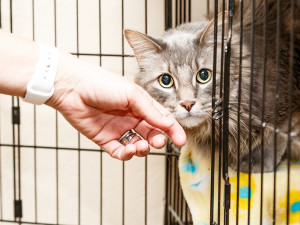Cat Allergies: Do Hypoallergenic Cats Exist?
If the sniffles are getting you down, don’t stress: You have options.

Share Article
If this story sounds painfully familiar, you’re definitely not alone. Cat allergies are incredibly common, afflicting almost a thirdopens in a new tab of the United States population. But what triggers these allergic reactions, and how can you prevent them from ruining your dreams of cat parenthood? Are there hypoallergenic cats that are ideal for allergy sufferers?
Kinship spoke to Dr. Payel Guptaopens in a new tab, medical director of allergy, asthma, immunology and ENT at LifeMD.com and Ease Allergy in Brooklyn, New York, about how to cope with a cat allergy and explored the reality of hypoallergenic cats.

Get (totally free) deals for food, treats, accessories, tech, and way more pet parenting must-haves.
opens in a new tabWhat are cat allergies?
Just like any other allergy, cat allergiesopens in a new tab are caused by your immune system incorrectly identifying an allergen as a threat and fighting against it. Allergies can often be caused by genetics, so if a parent or sibling has a cat allergy, you’re more likely to have one yourself. And allergic reactions to cats aren’t only caused by snuggling a feline — allergens can stick to clothes, furniture, bedding, and even circulate in the air, resulting in a sneezing fit, coughing, or a runny nose.
What causes cat allergies?
Contrary to popular belief, cat fur isn’t the source of most allergic reactions, so don’t start looking for hairless cats to adopt. There are 10 cat allergens that could be the cause of an allergic reaction in humans, but about 90 percent opens in a new tab of all cat allergies are caused by a protein known as Fel d 1opens in a new tab, which is produced by cats’ salivary glands and sweat glands. When a cat grooms with their tongue, this allergen is deposited on their fur and spread throughout the home environment.
If you suspect you may have a cat allergy, talk to your doctor about an allergy test. There are many other allergens in and around your home, such as dust mites, pollen, and mold, which can cause similar symptoms and may be the true triggers of your allergic reactions.
Can I get a cat if I’m allergic?
If you don’t already have a cat, adopting one when you know you have an allergy is generally not the best idea. “If you’re allergic to cats, it is generally not recommended to get a cat,” Dr. Gupta says. “However, some individuals with allergies can still live with cats by taking certain precautions and managing their symptoms.”
If you’re absolutely set on adopting a cat, make sure you’re prepared for the extra work that will go into keeping your home as allergen-free as possible and develop a strategy with your doctor for treating cat allergies (more on that below). When looking for a cat to adopt, you may want to set your sights on low-shedding breeds that will introduce fewer allergens into your home. And plan on keeping your cat solely inside to avoid outside allergens, such as pollen, making their way into the house (and to keep your cat safe).
Symptoms of Cat Allergies
Cat allergy symptoms vary from person to person. While some people may only deal with sneezing, itchy eyes, and a runny nose, others may have more severe reactions to cat allergies, like a rash or shortness of breath. Nasal congestion is a common symptom, as well as coughing as a result of post-nasal drip or allergy-induced asthma. These symptoms can appear immediately after an interaction with a cat or can take several hours to show up, depending on your sensitivity.
People with cat allergies may also experience fatigue if their allergies are not treated, and if allergens make their way into your lungs, you may experience more severe respiratory symptoms, such as wheezing and even difficulty breathing.
Do Hypoallergenic Cats Exist?
Hypoallergenic dog breedsopens in a new tab and mixes have been popular for years, especially for those who want to adopt a dog but suffer from allergies to pet dander. And there are hypoallergenic cat breeds as well that produce lower amounts of the Fel d 1 protein and are less likely to trigger allergic reactions as a result.
But it’s important to keep in mind that “hypoallergenic” means that these breeds produce lower levels of allergens. Any cat, regardless of breed, can still cause an allergic reaction, and every cat and human is different, so if you choose to adopt a cat when you have a cat allergy, understand that there are no cats who are allergy-free.
Are Cats Hypoallergenic?
All cats produce the Fel d 1 protein that can trigger an allergic reaction in humans, but some cats produce less Fel d 1 than others. For example, kittens produce less of the protein than adult cats, while female cats and neutered males produce less than unneutered males (yet another reason why neutering is important).
Some cat breeds shed less and produce less Fel d 1, making them safer bets for pet parents with cat allergies. Just keep in mind that you will likely still need to manage your allergy with home remedies, medications, and thorough cleaning because low-allergen is not the same as no-allergen.
Hypoallergenic Cat Breeds
If you have a cat allergy and want to adopt a cat that’s less likely to trigger a sneezing fit, look for these cats for people with allergies at your local shelter or rescue.
Siberian Forest Cat
Although the Siberian Forest Cat is a long-haired breed, they’re surprisingly one of the most hypoallergenic cats out there, thanks to their low levels of Fel d 1. The national cat of Russia, this breed is known for their mouse-hunting skills as well as a playful and active nature, making the Siberian Forest Cat a perfect family pet.
Devon Rex & Cornish Rex
Both of these similar breeds have soft, short coats, which results in limited shedding and infrequent grooming, which means less of those nasty allergens hanging around in your home. While the Devon Rex and Cornish Rex don’t produce less Fel d 1 like the Siberian Forest Cat, their less-frequent grooming habits mean that less of the protein is released into their environment.
Russian Blue
If you’re looking for a hypoallergenic cat breed with some dog-like behaviors, the Russian Blue may be the perfect fit. These cats boast plush, thick fur coats as well as lower levels of Fel d 1, keeping the number of allergens they release more limited. Plus, the Russian Blue is a very social breed and will even greet you at the door when you come home.
Balinese
The Balinese is often thought of as a long-haired Siamese cat because of their similar coloring. This breed does boast a fluffier fur coat than the short-haired Siamese. It also produces less Fel d 1, making them a good option for cat parents with allergies.
Oriental Shorthair
With both a low shedding rate and a low Fel d 1 production rate, the Oriental Shorthair has an easy-to-maintain coat and is less likely to trigger skin or respiratory allergies in its parents.
How to Treat Cat Allergies
If you already have a cat at home and develop an allergy, there are plenty of ways to treat cat allergy symptoms and still keep your cat in your life opens in a new tabwhere they belong.
What triggers cat allergies?
An allergic reaction happens when your body treats a substance from a cat, most likely the Fel d 1 protein, as something dangerous. As a result, your immune system puts up its defenses to attack, resulting in symptoms including irritated eyes, sniffling and sneezing, or even hives, rashes, and difficulty breathing.
How to Prevent Cat Allergies
Fortunately, there are ways you can prevent allergic reactions even with a cat in the home. Bathing and grooming your cat more frequently can help reduce the amount of dander in your home. To prevent an allergic reaction, you may want to wear a mask when grooming your cat or, if your symptoms are particularly severe, consider investing in the services of a professional groomer.
Unfortunately, snuggling in bed with your cat is out of the question if you have an allergy, according to Dr. Gupta. “Keep the cat out of the bedroom, since this is where you spend a majority of your time in the home while sleeping, and limit their access to certain areas of your house,” Dr. Gupta says.
Simple home cleaning can also help limit the amount of allergens in your space. For a cat allergy, dander is the main allergen you need to worry about, and regular vacuuming and dusting can help reduce the level of dander in your home. Take special care to clean any upholstered surfaces where your cat may rest, like furniture, bedding, or cat toys or beds. You may even want to consider ditching carpets and rugs for wood or tiled flooring, or washable rugs.
Keeping your home clean isn’t just about dusting. You can also install high-efficiency particulate absorbing (HEPA) air filters on your heating and cooling systems to help filter out allergens like pet dander, pollen, and dust mites.
Home Remedies For Cat Allergies
If your symptoms from your cat allergy aren’t too severe, you can often treat them with a number of home remedies, such as rinsing your nasal passages with saline.
Medications For Cat Allergies
Sometimes, home remedies just don’t cut it, or they need a little extra help. Over-the-counter medications can play a big role in reducing symptoms and making your cat allergy significantly easier to live with. Some of the options available in your local pharmacy include:
Antihistamines, such as Allegra, Claritin, or Zyrtec
Corticosteroid nasal sprays, such as Flonase or Nasonex
Antihistamine nasal sprays, such as Astepro
For more severe symptoms, you may consider immunotherapy, also known as allergy shots. These shots are designed to increase your tolerance to a specific allergen through regular exposure. Generally, you receive allergy shots once or twice a week for about six months and then monthly booster shots for several years.
If your allergy symptoms are particularly uncomfortable or hard to live with, talk to your doctor about a potential treatment plan. They may refer you to an allergist, who will work with you to find a combination of home remedies and medicine for your allergy to cats that works best for your symptoms and allows you to live a more comfortable life.
“It’s important to consult with a healthcare professional to determine the most suitable medication and dosage for your specific allergies,” Dr. Gupta says, because every person — and their allergy — is different.
Living with Cat Allergies
“Even with the best efforts, complete avoidance of cat allergens may not be possible,” Dr. Gupta says. “It’s essential to assess your own sensitivity and tolerance level before deciding to live with a cat if you have allergies. Spend time in homes with cats to gauge your reaction and consider consulting with an allergist to understand the potential risks and management options.”
A large segment of the population lives with cat allergies, and many of those people also have a cat, so don’t put your dreams of pet parenthood aside at the first sign of sneezing. By working with medical professionals, you can find the right solutions to help you manage your cat allergy and still spend plenty of quality time with your favorite feline companion.
FAQs
Can I get a cat if I’m allergic?
Most allergists don’t recommend adopting a cat if you know that you are allergic. However, if you are set on finding a feline friend, look for breeds that produce fewer allergens and take steps to keep your home clean.
Are there medications or treatments for cat allergies?
Most over-the-counter allergy medications can help with the symptoms of cat allergies, such as antihistamines, corticosteroid nasal sprays, and antihistamine nasal sprays. For more severe allergies, you may want to talk to your doctor about immunotherapy (allergy shots) and other treatment options.
What is the best home remedy for cat allergies?
Most home remedies work best in partnership with allergy medications and other treatments. You can rinse your nasal passages with saline to help reduce congestion and sneezing and keep your home allergy-free with frequent vacuuming, HEPA filters, and mopping.
What is the fastest way to get rid of cat allergies?
Unfortunately, there is no way to completely cure cat allergies, but there are plenty of medications and treatments that can help you live with your symptoms. Talk to your doctor about your options and how best to use over-the-counter medications, home remedies, and other treatments, such as immunotherapy, to improve your symptoms.
What are cat allergies triggered by?
Cat allergies are triggered not by cat fur, but by a protein called Fel d 1, which can be found in cat sweat and saliva glands. All cats have some level of this protein, but some cats produce less than others.
Resources

Savannah Admire
Savannah Admire is a writer, poet, and pet mom to three dogs and a cat. She currently lives in Western Maryland. When she’s not writing, you can find her reading, taking photos, or volunteering as a content creator for her local community theatre. Her debut poetry book, Mother Viper, is due out August 12, 2025, and you can follow her on Instagram at @savannahcooperpoetopens in a new tab.
Related articles
- opens in a new tab
Should I Adopt a Young or Adult Pet?
Age isn’t always just a number.
![A woman staring at her computer while holding her dog close.]() opens in a new tab
opens in a new tab10 Things to Consider Before Adopting a Pet
It’s a big decision, so check these boxes before you sign on the dotted line.
![two bonded kittens snuggling]() opens in a new tab
opens in a new tabWhy You Should Adopt a “Less Adoptable” Cat
Here’s why bonded kitties, senior cats, and felines with FIV make just as amazing pets as any other.
![two girls bonding over a cute fluffy dog]() opens in a new tab
opens in a new tabHow 5 Pet Parents’ Lives Had a Glow-Up After They Got Their Pets
Turns out finding community isn’t so hard when you’ve got a cute pal to help get you out of the house.
![White and brown cat staying at a nice hotel.]() opens in a new tab
opens in a new tabSleep-Away Camp For Kitty? The Pros and Cons of Boarding Your Cat
Keep these tips in mind when you’re looking for a quality spot to board your cat.
![Two black cats staring out window.]() opens in a new tab
opens in a new tab5 Signs You Should Get Your Cat a Cat
People, let me tell you ’bout (your cat’s) best friend.














